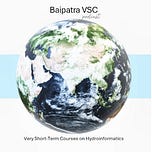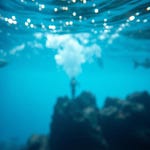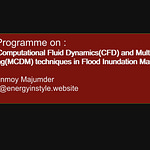The tutorial aims to apply the Evamix MCDM technique and glow warm optimization technique in hydroclimatic vulnerability analysis of islands. Islands are becoming increasingly vulnerable due to climate change and large-scale urbanization, as they have a finite natural resource. To achieve this, the first step is to select relevant parameters that can represent the vulnerability of the islands. This involves discussing with stakeholders and multidisciplinary experts, as well as referring to various literatures.
The second step is selecting criteria based on which we will compare the parameters or features. The methodology known as PEST (Political Interference, Environmental Impact, Socio-economic Impact, Technical Impact) is used to determine the priority of each parameter in representing the hydroclimatic vulnerability of violence. However, not all parameters are equally significant or important, and in the present studies, only 10 or 5 of them are considered important.
To address this issue, the tutorial will only apply the Evamix MCDM method, as it has proven its capability in finding the most significant parameters among all relevant parameters. This method is popular nowadays and has proven to be effective in finding the most significant parameters among all relevant parameters.
The goal of this study is to find the main parameters that are enough to represent the vulnerability of an idea, rather than trying to give equal importance to all 50 or 60 parameters. By identifying the most significant parameters, the focus can be moved forward with the vulnerability analysis. The tutorial emphasizes the importance of using objective methods like MCDM techniques to make the method of parameter selection more efficient and effective.
Content
Introduction
Significance
A Hydro-Climatic Vulnerability Analysis of Islands is significant because it allows researchers and policymakers to identify and understand the specific threats posed by changing water availability and weather patterns on island ecosystems, enabling targeted adaptation strategies to mitigate the impacts of climate change, which often disproportionately affect island communities due to their geographic isolation and limited landmass; this analysis is crucial for protecting infrastructure, livelihoods, and biodiversity in vulnerable island regions.
Key points about the significance of this analysis:
High vulnerability:
Islands are inherently more vulnerable to climate change impacts like sea level rise, extreme weather events, and altered precipitation patterns, making a detailed analysis of their hydro-climatic vulnerabilities critical.
Early warning system:
This analysis can provide an early warning system to prepare for potential disasters and implement preventive measures by identifying areas most susceptible to water scarcity, flooding, or saltwater intrusion.
Informed decision-making:
The analysis helps decision-makers prioritize adaptation strategies based on the specific vulnerabilities of each island, allowing for targeted investments in infrastructure development, water management, and disaster preparedness.
Economic and social impact assessment:
The analysis can assess the economic and social consequences of climate change on island populations by understanding the potential impacts on water resources, agriculture, and coastal communities.
Biodiversity conservation:
Islands often harbour unique ecosystems, and hydro-climatic vulnerability analysis can help identify areas critical for conservation efforts to protect vulnerable species from climate change threats.
Key elements of a Hydro-Climatic Vulnerability Analysis:
Climate data analysis:
Assessing changes in rainfall patterns, temperature trends, and extreme weather events.
Hydrological modeling:
Evaluating water availability through analysis of surface water runoff, groundwater recharge, and potential impacts on freshwater resources.
Coastal dynamics analysis:
Studying potential impacts of sea level rise on coastal erosion and saltwater intrusion.
Socio-economic factors:
Incorporating data on population density, livelihood dependence on water resources, and community resilience to assess vulnerability levels.
Research Gaps
Research gaps in hydro-climatic vulnerability analysis of islands include:
Water supply projections
There is a need for research on how water supplies will change in the future.
Water governance
There is a need for research on how to manage water resources, including legislation and institutional arrangements.
Water loss detection
There is a need for research on how to detect water loss and implement strategies to reduce it.
Adaptation feasibility
There is a need for research on the feasibility, outcomes, and sustainability of adaptation responses.
Adaptation financing
There is a need for research on how to increase adaptation financing for small islands.
Methods for assessing climate-induced losses
There is a need for research on how to assess the losses and damages caused by climate change.
Small Island Developing States (SIDS) are particularly vulnerable to climate change. This is due to many factors, including their small population size, remoteness, and lack of economic alternatives.
Objective
Methods Used
EVAMIX
GWO
Detail Methodology
Selection of Relevant Parameters
Selection of Hydro-Climatic Criteria
Development of Index of Vulnerability
Application of GWO to Find the Maximum Vulnerability from the Index
Case study area selection and comparison of vulnerability with Maximum Vulnerability
Result
Discussion
Conclusion
Further Reading : Fundamentals of Optimization Techniques
To purchase 50 ideas for Starting a Business in US dollars: Click here
Simplify website creation with AI(AD)
Click here to Upgrade and access the above content for more than seven days. Free members can access the content only for seven days after publication.
If you want to pay in INR then do so by clicking here
Embrace the opportunity to learn about Artificial Intelligence, Flood Prediction, Water Resource Management, and more by clicking here.. You may also promote and earn money selling educational products by becoming an affiliate of Innovate S : our digital shop. I understand that it's important to give young entrepreneurs the opportunity to promote their startups. Click here to learn more.
The information provided above is presented in the order in which it was received from the source. The application link and dates are the same as those that were provided by the source. Shared knowledge is based on what is received. the author of this post and HydroGeek are not liable for any liability or damage resulting from the use of this information. Additionally, our Terms and Conditions, Cancellation and Refund Policy as well as our Privacy Policy are presented here for your perusal. After taking into account the honorarium and the cost of maintenance, the amount that is obtained in exchange for the membership fee or through any other methods, if any, is then donated to non-profit organisations.
Festival Offers going on in AJIO (AD)
How to join the internship program ?
If you are interested in joining the internship please give a Comment or DM me or email me at contact@baipatra.ws
Subscribed
You may also like
Very Short-Term Course on Hydroinformatics
My YouTube Channel: Mrinmoy’s Views
Call for Paper for Virtual Forum on Water and Environment 2025
Lecture Notes on MCDM: Learn with Example 12 MCDM Techniques
Artificial Intelligence and its Application on Water Resource Development
Host and Earn(AD)










Share this post